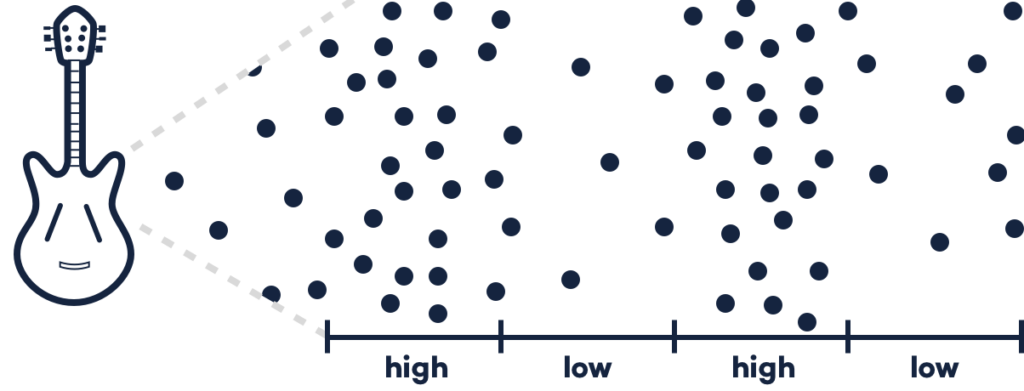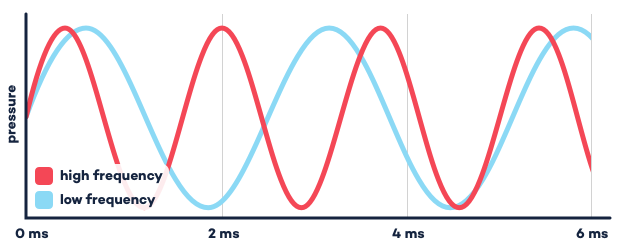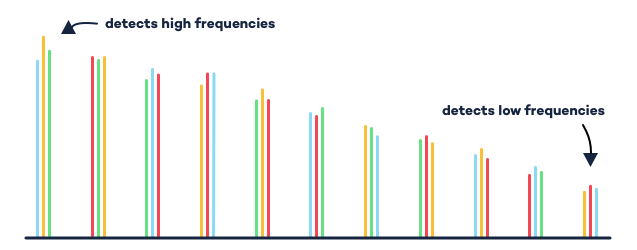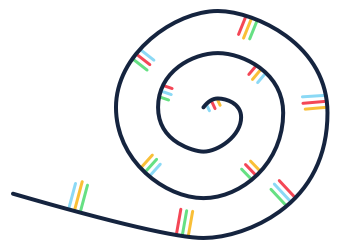Build Your Skills
Learn music theory Train your ears Track your tempoRead Now
Get the Newsletter
Categories
- | BeatMirror (10)
- | HearEQ (11)
- | Waay (22)
- | WaayFinder (1)
- Audio (16)
- For musicians (34)
- Guitar (2)
- Music theory (15)
- News (42)
- Startup stories (2)
- Tutorial (4)
Keep in Touch
About Ten Kettles
We love music, we love learning, and we love building brand new things. We are Ten Kettles.
Read more >-
August 26, 2021
Nature of Hearing
In our last article, we talked about the Nature of a Note: what exactly is sound, and how does it travel from an instrument to your ear? In today’s article, suggested by reader Michael C., we look at the next step in our note’s journey. How does our ear make sense of those wobbling air molecules we call sound?
In other words, how does our body turn sound into music?
What is sound?
Let’s review. When we pluck a guitar string, it vibrates back and forth. With each vibration, it smacks into the surrounding air molecules and sends them flying away. Those air molecules then collide into other neighbouring molecules before bouncing back again.
All this bouncing back and forth creates a pressure wave: areas of high pressure (i.e., lots of molecules) and low pressure (fewer molecules) moving along through the air towards your ear.

When we play a high note, the string vibrates rapidly. This creates high and low pressure areas that are very close together. Because the pressure changes are so frequent, we say the pressure wave has a “high frequency.” For a low note, the string vibrates more slowly. This means that the high/low pressure areas are farther apart, and so we’d say the wave is “low frequency.”

How do we hear sound?
Inside of our ears is a line-up of wonderful little frequency detectors. Like a bunch of kids lined up from tallest to smallest, these detectors are arranged in order from high frequency to low frequency. The detectors on one side detect the highs (and only the highs) and the detectors on the other side detect just the lows. The detectors in the middle detect—you guessed it—the middle frequencies.

So what are these “detectors”? Well, each detector is actually a tiny clump of hairs sticking out of a cell. These little hairs are extraordinary. Each hair is of a particular size and shape such that it wiggles when certain frequencies—and only those frequencies—enter the ear. This is like how certain sounds can make windows rattle or our chests vibrate.
When a sound wave enters the ear, the corresponding hairs start to wiggle—and the attached cell takes notice. It alerts the brain: “We’re hearing a sound at this frequency!” If the hairs wiggle a lot, we hear a loud sound; if they wiggle just a bit, we hear a quiet sound.
Now, like a rolled-up sleeping bag, our “line-up of frequency detectors” is rolled up too. It’s curled up into a little spiral which looks like a snail. It’s fitting then that we call it a cochlea (coke-lee-uh / ˈkō-klē-ə), which means snail.

Time for an example. Here’s a mid-frequency sound. Take a listen:
The sound wave hits your ear like a gust of wind blowing through the middle of your cochlea. The low-frequency detectors, like big wooden posts in a storm, take no notice. Their cells stay quiet and your brain doesn’t hear any low noises. The high-frequency hairs don’t wiggle either, and so your brain isn’t sent any “this is a high frequency!” messages.
Just the hairs in the middle of our cochlea move with the sound wave. Those hairs wiggle their cells, sending an excited alert to your brain: “we’re hearing a mid-frequency sound!” So that’s what your brain does—hears a mid-frequency sound.
Enter the music
Unlike the sound sample above, most sounds we hear aren’t only one frequency. They’re a whole bunch of frequencies coming through at the exact same time, some louder and some softer. This chorus of sound waves plays our cochlea like a piano. Our brain combines all those different signals into the music and sounds we know and love.
Understanding that sounds are made up of many different frequencies has enormous value. For one thing, it lets us turn up and down different frequencies using a sound equalizer (that’s what hearEQ is all about). A long time ago, it also allowed us to send sound signals across the world in the first telephones. All we had to do was filter out the non-essential frequencies in our voices first!
But perhaps most of all, it lets us experience—and gain insight—into the full sonic colour of the world around us. The distant low-frequency rumbling of the streetcar on its track. The high-pitched chatter of birds near the window. The mids of muffled conversation from elsewhere in your home. And, of course, music.
All thanks to the little snail in our ears. 🙂
Looking for Part 3 of this series? Read Everything is Beeps now.



Comments